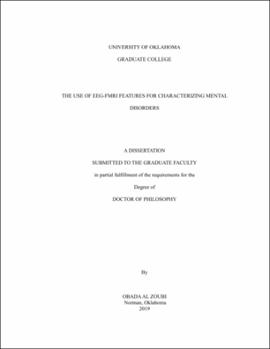| dc.description.abstract | Determining clinically relevant biomarkers of mental disorders for reliably indicating pathophysiological processes or predicting therapeutic responses remains a major challenge, despite decades of research. Identifying such biomarkers can help patients significantly improve their quality of life and alleviate their suffering. Electroencephalography (EEG) and functional magnetic resonance imaging (fMRI) are non-invasive tools to investigate neurobiological mechanisms underlying mental disorders. Extracting and leveraging informative features from the high temporal resolution EEG and high spatial resolution fMRI may offer a more comprehensive understanding of brain spatial and temporal activities in health and disease. More importantly, this information can lead to a better understanding of the neurobiology of mental illness. This dissertation investigates the analyses and applications of extracting and combining informative features from EEG and fMRI, along with applying machine learning (ML) and computational methods for building biomarkers of mental illnesses.
Several methodological challenges in the extraction of informative and reproducible features are also addressed. First, two types of EEG features obtained from resting state EEG-fMRI measurements were extracted: 1) broadband-multichannel EEG dynamical features, called EEG microstates (EEG-ms); and 2) heterogeneous, static EEG features. Using EEG features only, results elucidate that: 1) EEG-ms characteristics and information theoretical properties can successfully differentiate individuals with mood and anxiety disorders from healthy comparison subjects with potential applications for other clinical groups; and 2) heterogeneous static EEG features can successfully predict “brain aging,” noted here as BrainAGE from 468 EEG datasets, achieving a correlation of r=0.61 between predicted age and chronological age.
Next, extracted EEG features were leveraged with fMRI to enhance the predictivity of BrainAGE and localizing the associated EEG-ms brain regions. More specifically, static EEG features were combined with resting state fMRI features to construct a multimodal BrainAGE predictor as a case study. Notably, it was found that EEG and fMRI contain a large portion of shared information about age, although each modality has its fingerprint of the aging process. The developed approach is a general purpose and be applied to predict other outcomes from brain imaging data. Similarly, EEG-ms features were integrated with fMRI to localize associated brain regions within fMRI space, revealing functional brain connectivity changes in individuals with mood and anxiety disorders as a case study. As a result, harnessing combined EEG-fMRI methods have enriched our knowledge some mental disorders and broadened our understanding of them with potential applications for other clinical groups and outcomes. Finally, this work evaluated the reproducibility and replication of EEG-ms analysis to address technical issues that have thus far been overlooked in the literature.
In conclusion, the presented work describes technical methods developed to study and discover several clinically translatable biomarkers that can be reliably used to characterize various mental disorders. | en_US |
